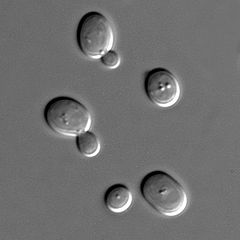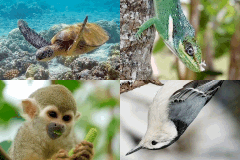 AnAge entry for Saccharomyces cerevisiae
AnAge entry for Saccharomyces cerevisiae
Classification (HAGRID: 04242)
- Taxonomy
-
Kingdom: Fungi
Phylum: Ascomycota
Class: Saccharomycetes
Order: Saccharomycetales
Family: Saccharomycetaceae
Genus: Saccharomyces
- Species
- Saccharomyces cerevisiae
- Common name
- Baker's yeast
- Synonyms
- Candida robusta, Saccharomyces ellipsoideus
Lifespan, ageing, and relevant traits
- Maximum longevity
- 0.04 years (captivity)
- Source
- Multiple references, please see bibliography below
- Sample size
- Large
- Data quality
- Acceptable
- Observations
The budding yeast suffers from clonal or replicative senescence in which each mother cell can only divide a limited amount of times to produce daughter cells; the number of divisions by the mother cell is thus used to determine lifespan. The accumulation of extrachromosomal ribosomal DNA circles has been suggested as a possible causal mechanism of replicative senescence [0045]. It is also possible to measure chronological lifespan in yeast in terms of stationary phase survival; that is, the survival of individual cells in a non-dividing state. Longevity varies considerably between strains and various manipulations, including caloric restriction which in yeast consists of reducing the glucose level, increase lifespan [0981]. Caloric restriction replicative lifespan extension in yeast has been reported to be a non-cell autonomous process. Conditioned medium from caloric restriction treated cells transmits the longevity benefit of caloric restriction to moved mother cells, suggesting the process may benefit neighbouring cells, not only the individual cell [1209].
Several genes have been identified that regulate clonal senescence or chronological lifespan [0056], but because these two measurements are fundamentally different some genes have been shown to have opposite effects on them [0746].
Life history traits (averages)
- No information is available on life history. Please contact us if you wish to suggest or contribute data.
Metabolism
No information on metabolism is available.
Species in other databases
References
- [1209] Mei and Brenner (2015), Calorie restriction-mediated replicative lifespan extension in yeast is non-cell autonomous (PubMed)
- [0937] Unal et al. (2011), Gametogenesis eliminates age-induced cellular damage and resets life span in yeast (PubMed)
- [0932] Kaeberlein (2010), Lessons on longevity from budding yeast (PubMed)
- [0981] Wolf and Austad (2010), Introduction: Lifespans and Pathologies Present at Death in Laboratory Animals
- [0936] Shcheprova et al. (2008), A mechanism for asymmetric segregation of age during yeast budding (PubMed)
- [0460] Kaeberlein et al. (2007), Recent developments in yeast aging (PubMed)
- [0746] Kennedy et al. (2005), The enigmatic role of Sir2 in aging (PubMed)
- [0004] Fabrizio and Longo (2003), The chronological life span of Saccharomyces cerevisiae (PubMed)
- [0337] Tissenbaum and Guarente (2002), Model organisms as a guide to mammalian aging (PubMed)
- [0056] Kaeberlein et al. (2001), Using yeast to discover the fountain of youth (PubMed)
- [0015] Jazwinski (2001), New clues to old yeast (PubMed)
- [0053] Guarente and Kenyon (2000), Genetic pathways that regulate ageing in model organisms (PubMed)
- [0012] Gershon and Gershon (2000), The budding yeast, Saccharomyces cerevisiae, as a model for aging research: a critical review (PubMed)
- [0069] Gershon and Gershon (2000), Paradigms in aging research: a critical review and assessment (PubMed)
- [0338] Sinclair (1999), Yeast aging research: recent advances and medical relevance (PubMed)
- [0045] Sinclair and Guarente (1997), Extrachromosomal rDNA circles--a cause of aging in yeast (PubMed)
- [0044] Lundblad and Szostak (1989), A mutant with a defect in telomere elongation leads to senescence in yeast (PubMed)
External Resources
- Integrated Taxonomic Information System
- ITIS 194157
- Animal Diversity Web
- ADW account (if available)
- Encyclopaedia of Life
- Search EOL
- NCBI Taxonomy
- Taxonomy ID 4932
- Entrez
- Search all databases
- Ageing Literature
- Search Google Scholar or Search PubMed
- Images
- Google Image search
- Internet
- Search Google

